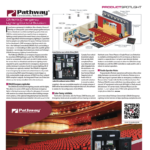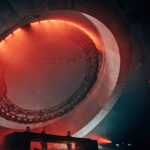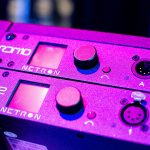The search for the perfect strobe light to replace the original Atomic model has been endless. Over the last three years, every lighting manufacturer has released their version of what they think the designers wanted. All LED models, it seems, as nobody wants to deal with the old tube style strobe, their power draw or the fact that they could thermal out after a few seconds. They built all white models, colored models, models with chasing quadrants.
But to this designer’s eye, they were all missing something. Mostly it was the attack and decay one gets from the old xenon strobe. A good programmer can usually emulate it with clever timing on cues, but there had to be an easier way.
Strobes were originally used as an effects type fixture. You would aim them at a performer and adjust the rate until the artist looked like they were moving in slow motion via an old 8mm black and white movie. But along came rock shows, and designers preferred to burn the retinas of the attendees. So what did all the LD’s do? They pointed their strobes out at the audience to get the maximum effect out of the fixtures while blinding them into a trance. That made it impossible to point the same fixtures at the band to get the other desired effect. Thank goodness GLP has put an end to all of this. May I present to you the best strobe I have ever seen — the JDC1 Strobe from German Light Products (GLP).

The Light Source
First off, there is no Xenon bulb. The old worries that they were going in the direction of needing loads of amperes to run 3000 watts of power is dismissed. The shape of this model is rectangular, as we have grown to love and expect in this type fixture. Spanning the center line is a thin traditional tube element, which is clear. Inside that tube reside 216 white Cree XP L LEDs. They can be separated down into 12 sections to chase if desired. As per most of the LED strobes on the market, it is too powerful to stare at when running at full. The software allows for many different modes as well as macro type effects. One of the things GLP is fine tuning right now is the attack and decay emulation of the old gas bulb models through a function on this fixture. They are also adding more macro type effects for the end user to make programming easier.
The center tube emits a slightly directional beam itself. It has a beam angle of about 70 degrees. They have no use for any internal reflector. Instead, GLP has surrounded the center white line with an additional 1440 Osram RGB LED’s. These blend most colors smoothly and can act as a general wash as well. The colored LEDs have a native beam angle of 100 degrees. These RGB lights break down into 12 sections or less, depending on the operating mode one chooses. These colors are extremely bright as well. One can chase between the colored light and the white light sources for this amazing visual effect.
Control of the fixture is done through DMX-512 and a 5-pin XLR Input/output panel mount connector. The fixture also accepts RDM (bidirectional) commands. One can control the fixture in modes ranging from a basic 4 channel white strobe mode to 66 channels of pixel mappable beauty.

It Moves!
Finally, a strobe with a tilt function. Every LD appreciates a good sweep down of strobing moving lights, but they never have the “whack you in the face” effect that a strobe fixture possesses. Due to the 190° tilt range, it’s now possible to sweep your strobes themselves through the crowd. The fixture’s tilt is smooth in a 16-bit mode and quick when necessary. It takes the fixture less than a second to complete a zero to full tilt. Most important, you can now decide where to direct your strobe. One can point them straight down to just light the stage, or upstage at a backdrop where they can double as a color changing cyc light. With the ability to maintain a steady intensity, they also make a splendid crowd blinder of any color.
The fixture can take between 100-240V at 50/60 Hz. Power is applied through a Neutrik TRUE1 panel mount connector. It draws 1200 watts with every LED at full. Because it can draw 10 amps at 100 volts, these fixtures cannot daisy chain their AC. They can operate in any physical mounting position. There are Omega brackets to hang the fixture or rubber feet to keep it off a slick deck. The fixture is temperature controlled with overheating protection and the use of six fans — two in the base and four in the head. They do not come on until needed and, even then, are fairly silent. But face it, if the strobes are flashing steadily long enough for the fans to come on, there is loud music or screaming involved and the other kind of fan noise is a non-issue.
The fixture comes in a basic black color, but they will custom color it if you request it. It weighs 25.6 lbs. Without any clamps or brackets, the JDC1 is 15.3 inches long by about six inches wide. It stands 9.8 inches tall when the head is tilted vertically. A scratch proof, tempered glass cover protects the LEDs from damage, but the fixture is not weatherproof. The LCD display is easy to maneuver and address the fixture and mode. It has a self-charging buffer battery in it as well.
At a Glance
Re-inventing the Hybrid Strobe
With all the various uses this fixture has, GLP has reinvented the hybrid strobe as we know it. Setting the bar high, the JDC1 may possibly become the most popular strobe light ever.
GLP JDC1 Strobe
FEATURES
- Motorized tilt
- Emulates a Xenon strobe
- Can act as a strobe, wash light or blinder
- Pixel-mappable
- Compact size
- Great effects
SPECS
- Size: 15.3” x 5.9” x 9.8” (LxWxH)
- Weight: 25.6 pounds
- Watts: 1200W
- Light Sources: 216 white Cree LEDs, 1440 Osram RGB LEDs
- Beam sizes: 45° (white), 100° (RGB)
- MSRP: $6,249
- Manufacturer: GLP
More Info: www.germanlightproducts.com


